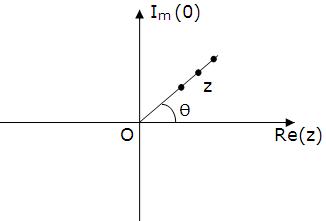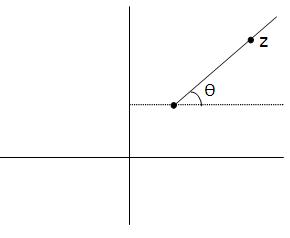Important Results in Context with Rotation
 (i) arg z = 0 represents points (non-zero) on a ray emanating from origin making an angle θ with positive direction of real axis.
(i) arg z = 0 represents points (non-zero) on a ray emanating from origin making an angle θ with positive direction of real axis.
(ii) arg (z-z1)= 0 represents points ( ≠3,) on ray emanating from z, making an angle θ with positive direction of real axis.
Rotation theorem:
(i) If P(z1) and Q(z2) are two complex numbers such that |z1| = |z2|, then z2=z1 eiθ, where θ = ⁄POQ.
(ii) If P(z1), Q(z2) and R(z3) are three complex numbers and ⁄PQR=Q, then
(iii) If P(z1), Q(z2), R(z3) and S(z4) are three complex numbers and ⁄STQ= θ, then
2. amp (z) = θ is a ray emanating from the origin inclined at an angle θ to the x-axis.
3. |z-a|=|z-b| is the perpendicular bisectors of the line joining a to b.
4. The equation of a line joining z1 and z2 is given by z = z1 + t(z1-z2) where t is a real parameter.
5. z = z1 (1+it) where t is a real parameter is a line through the point z, and perpendicular to the line joining z, to the origin.
6. The equation of a line passing through z1 and z2 can be expressed in the determinant form as

This is also the condition for three complex numbers z, z1, z2 to b collinear.
7. The equation of a circle having centre z0 and radius p is:
|z-z0| = p or z - z0
- z0 -
-  0 - z +
0 - z +  0z0 - p2 = 0 which is of the form
0z0 - p2 = 0 which is of the form
z +
+  z + α
z + α + k = 0, k is real.
+ k = 0, k is real.
Centre is -α and radius =√(α - k) circle will be real if α
- k) circle will be real if α - k ≥ 0.
- k ≥ 0.
8. The equation of the circle described on the line segment joining z1 and z2 as
diameter is arg (z-z2)/(z-z2 )= ±Π/2 or (z-z1) ( -
- 2)+(z-z2 )(
2)+(z-z2 )( 1)=0
1)=0
9. Condition for four given points z1, z2, z3 and z4 to be concyclic is the number
(z3 z1)/(z3-z2 ).(z4 z2)/(z4-z1 ) should be real.
Hence, the equation of a circle through 3 non-collinear points z1, z2 and z3 can be taken as
(z-z1 )(z3-z1 )/((z-z1 )(z3-z2)) is real
=> (z-z2 )(z3-z1 )/((z-z1 )(z3-z2))=( -
- 2 )(
2 )( 3-
3-  1)/((z-z1 )(z3-z2))
1)/((z-z1 )(z3-z2))
10. Arg((z-z1)/(z-z2)) = 0 represent
(i) a line segment if θ =Π
(ii) pair of ray if θ = 0
(iii) a part of circle, if 0<0<Π
11. Area of triangle formed by the points z1, z2 and z3 is

12. Perpendicular distance of a point z0 from the line
 z + α
z + α + r = 0 is |(
+ r = 0 is |(  z0 + α
z0 + α + r )/α|α||
+ r )/α|α||
13. (i) Complex slope of a line  z + α
z + α + r = 0 w = - α/α
+ r = 0 w = - α/α
(ii) Complex slope of a line joining the points z1 and z2 is w=(z1- 2)/(z1-
2)/(z1- 2)
2)
(iii) Complex slope of a line making Q angle with real axis w=l2iθ
14. Dot and Cross product
Let z1 = x1 + i y1 and z2 = x2 + i y2 be two complex numbers (vectors). The dot product (also called the scalar product) of z1 and z2 is defined by z1.z2 = |z1| |z2| cos θ
= x1x2 + y1y= = Re { 1z2}
1z2}
= 1/2{ 1z2 + z1
1z2 + z1 2}
2}
Where θ is the angle between z1 and z2 which lies between 0 and Π .
If vectors z1, z2 are perpendicular then z1.z2 = 0 => z1/z2 + z2/z2 = 0
i.e. sum of complex slopes = 0
The cross product of z1 and z2 is defined by
z1 × z2 = |z1| |z2| sin θ|
= x1y2 - y1x2
= Im{ 1z2 }
1z2 }
= 1/zi ( z2 - z1
z2 - z1 2)
2)
If vectors z1, z2 are parallel then z1 × z2 = 0 z1/z2 = z2/z2
i.e., complex slopes are equal.
Note:
w1 and w2 are complex slopes of two lines.
(i) If lines are parallel then w1 = w2
(ii) If lines are perpendicular then w1 + w2 = 0
15. If |z-z1| + |z-z2| = K> |z1-z2| then locus of z is an ellipse focii are z1 and z2.
16. If |z-z0| = | z + α
z + α + r/2K1| then locus of z is parabola whose focus is z0 and directrix is the line
+ r/2K1| then locus of z is parabola whose focus is z0 and directrix is the line
 z + α
z + α + r = 0 (provided
+ r = 0 (provided  z0+ α
z0+ α 0 + r ≠ 0)
0 + r ≠ 0)
17. If |(z-z1)/(z-z2)| = k < |z1-z2| then locus of z is a circle
18. If then locus of z is a hyperbola, whose focii are z1 and z2.
To read more, Buy study materials of Complex Numbers comprising study notes, revision notes, video lectures, previous year solved questions etc. Also browse for more study materials on Mathematics here.



